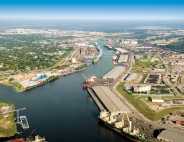Next Level Warehousing and Distribution
22 Nov, 2013
By Mark Kleszczewski
Trends include more automation and same-day delivery.
When asked to think of a warehouse or distribution center, people typically picture a cavernous building full of workers maneuvering forklifts around racks, pallets and loading docks. But today’s warehousing and distribution industry is more than just moving loads of boxes from point A to point B. The sector is full of innovative opportunities and playing a crucial role in forming a next-generation supply chain that’s benefitting consumers and communities alike.
“Warehousing and distribution have not traditionally been the most celebrated functions within leading businesses across manufacturing, retail and wholesale industries,” notes Mark Wheeler, director of warehouse solutions, Motorola Solutions. “Our Future of Warehousing Survey revealed that these functions are playing a more important role as businesses face new pressures to cut costs to enhance profitability and free up capital as well as drive competitive differentiation and business growth.”
While controlling costs indeed remains a key factor for most companies and shippers, the advent of same-day delivery, new technologies, sustainability, transportation shifts and increasing regulation are also having an impact on the warehousing operations across the country.
According to the U.S. Bureau of Transportation Statistics, freight shipments are up 5.2 percent since August 2008 and up 10.5 percent in the 10 years from August 2003. Most of the increase since October 2012 was in trucking and rail intermodal shipments, the bureau reports.
The uptick is driving demand for warehouses and distribution buildings across the country, just as companies are also diversifying their sourcing locations, shipping smaller orders more frequently and getting more involved in value-added activities. The sector is also facing the impending expansion of the Panama Canal, the growth of intermodal transportation, and the escalating shortage of North American truck drivers, says Rajiv Saxena, vice president of global supply engineering, APL Logistics.
“Interest in sustainability is also continuing to grow, especially since making sustainable improvements often creates a win-win situation,” Saxena says. “Many ‘green’ supply chain improvements have the added benefit of cutting costs or improving efficiency right along with trimming carbon footprints.
“Companies and their supply chains are under huge pressures to cut costs, improve quality and accommodate a vast amount of complexity, and in many cases they’re also discovering that working with other companies besides their own — be those companies, suppliers, retail partners or competitors — is a great way to help achieve many of those goals,” Saxena adds.
“The decisions that must be made today are much more complex than in the past, when warehouses were simpler environments with forklifts and racks and less technology.”- Dan Camp, TerraPointe LLC
Specialized Sites
As the economy rebounds, communities are also investing in specialized, turnkey services and multi-purpose sites to serve a wide variety of industries.
“Overall, distribution centers are becoming more automated and specialized, from details such as roof and dock heights to the number of doors needed,” says Dan Camp, director of project management for strategic real estate, TerraPointe LLC. “The decisions that must be made today are much more complex than in the past, when warehouses were simpler environments with forklifts and racks and less technology.
“For example, we saw a distribution center that accommodated three types of uses in one warehouse: 1) receiving and storing materials for distribution in the owner’s supply chain; 2) direct shipments to the consumer (same-day delivery); and 3) overnight delivery from a store or ‘package out’,” Camp says. “Led by online retailers like Amazon, we’re also seeing a push toward same-day or next-day delivery. That means more distribution centers will be located in populous states like Florida and closer to major population centers.”
To illustrate, Camp points to his company’s 1,800-acre Crawford Diamond Industrial Park, located in Nassau County, Fla., which recently received megasite certification and is aimed at potential users in the food processing, machinery manufacturing and automotive OEM industries.
“The concept of inland logistics centers located close to major port facilities is getting a lot of traction,” adds Steve Rieck, executive director, Nassau County (Fla.) Economic Development Board. “And certification is the stamp of approval that many major companies now require before they’ll even consider a site for expansion or relocation, as it signifies the site is served with adequate infrastructure, properly zoned and relatively risk-free.”
The megasite is the only one in Florida where two Class I railroads intersect, making it an ideal location for a large-scale manufacturer or distributor. In addition to on-site CSX and Norfolk Southern frontage, the park is close to five deep-water ports, four marine terminals, two interstates and the Jacksonville International Airport.
Another growing area emphasizing supply chain and logistics activities is Greensboro, N.C., which is distinguished by large distribution hubs, sophisticated logistics companies and manufacturers who ship large quantities of goods from local facilities.
“We like to think of ourselves as the crossroads of the Mid-Atlantic,” says Dan Lynch, president, Greensboro (N.C.) Economic Development Alliance. “Not only do we have strong air and rail capabilities, we’ve been blessed with a real robust road structure which is the lifeblood of logistics and supply chain management.”
Located squarely at the intersection of I-40, I-85 and future I-73/I-74, Greensboro also offers convenient access to I-95 and major highways including US 29, US 220, NC 68 and NC 421. Amenities include UPS and FedEx Express hubs, Norfolk Southern and CSX for rail service and Piedmont Triad International Airport for air. These strong transportation networks, along with an experienced industrial workforce, have allowed companies such as Procter & Gamble, Piedmont Pharmaceuticals, LF USA, General Dynamics Advanced Technology Systems, Lenovo and others to expand in the area in recent years.
“Twelve years ago, we started to see the automotive companies migrating down here,” Lynch says. “And now we’re starting to see big aviation OEMs like Boeing and Gulfstream migrate into our region and the Southeast. So we’re putting a lot of our efforts into growing our aviation sector, which fits nicely into the manufacturing and distribution advantages we offer.”
Thanks to a diverse workforce, convenient location and focus on efficiency, even smaller places such as Maumelle, Ark., are also expanding in the sector yet without having to place all their bets on heavy industry.
“Having excellent road connections and companies like J.B. Hunt in the area makes it a perfect location for distribution,” says Judy Keller, director, community and economic development, city of Maumelle, Ark. “Plus we’re not saturated and have room for growth, especially for light manufacturing companies and retailers serving the growing Southeast market.”
Companies like Cintas, Medline Industries, Scholastic Book Fairs, Molex, BEI Precision Systems, Kimberly-Clark Corp. and ACE Hardware,Keller says, cite the I-40, I-30 and I-430 corridors merging nearby as a key factor in determining the Maumelle area as the primary location for effectively serving customers in several adjoining states.
“The port is a facilitator to help make shipments quicker and less costly, and with international commerce and the global trade ecosystem growing, we also provide access to customs brokers, legal providers, bankers and especially freight forwarders — where the rubber literally hits the road.”- Brent Case, Capital Region Airport Authority
Maumelle is also home to Little Rock-based Dillard’s, which took over a previous Target distribution facility to open its new Internet fulfillment center featuring the Kiva system of autonomous mobile robots.
According to commercial real estate leader Jones Lang LaSalle, speculative construction is back and becoming prevalent in logistics corridors, with future announcements anticipated in a handful of secondary markets. Tenant requirements are largely focused on the Midwest, Northeast and Southeast — regions whose vacancy rates exceed the national average and are poised to appreciate in the quarters ahead.
One such bright spot is in Lansing, Mich., where TOC Logistics International will open a new logistics office and Foreign Trade Zone warehouse at the Port Lansing Global Logistics Centre. The facility supports warehouse operations and freight consolidation for importers and exporters, a general purpose foreign trade zone and staging for air-cargo operations and other international trade services.
“Instead of having to use distant service providers and other congested freight hubs that can delay arrival of shipments, Port Lansing has attracted global logistics experts to provide those services locally,” says Brent Case, director of foreign trade zone and global logistics development, Capital Region Airport Authority. “We’re not just about air cargo though. Our strategic plan is to be able to provide all modes as best we can to all of our shippers in the region and throughout the state.”
Opportunities Await
As global trade networks expand, shippers are looking for proactive locations and nimble providers who can do much more than simply manage storage or transportation. Modern logistics centers that also offer increased flexibility, speed and environmental benefits can be a significant competitive asset for companies and strategically-located communities alike.
“The port is a facilitator to help make shipments quicker and less costly, and with international commerce and the global trade ecosystem growing, we also provide access to customs brokers, legal providers, bankers and especially freight forwarders — where the rubber literally hits the road,” Case says. “While most of our customers are in the automotive industry, there’s definitely potential for us to expand.”
“As a result of us being a center of manufacturing over the last 100 years, our warehousing and distribution cluster is firmly entrenched and has stayed healthy,” Lynch says. “No matter what, you’ve got to get raw materials in and finished products out, much faster and cheaper than before. Companies are recognizing that the rebirth of manufacturing goes hand in glove with distribution and supply chain expansion here.”
For complete details on the organizations featured in this article, visit:
Capital Region Airport Authority
Greensboro (N.C.) Economic Development Alliance
Nassau County (Fla.) Economic Development Board
Illustration by photoraidz at Free Digital Photos.net
Mark Kleszczewski
Mark Kleszczewski is president and CEO of GoBusiness Group LLC and a freelance writer on critical business topics. He can be reached at mark@gobusinessgroup.net.
Related Posts
-

Rail is Vital Link in Supply Chain Strategies
-

U.S. Rail Intermodal Volumes Surge
-

Modern Logistics Offers Competitive Edge
-

Answers to Data Questions are in the Cloud
-

Appetites Return to Food Processing
-

The Smooth (Headquarters) Operators
-

Trucking Faces the Future
-

Seaports get Ready for Supersizing
-

Warehousing and Distribution: Looking Beyond Cost Reductions









